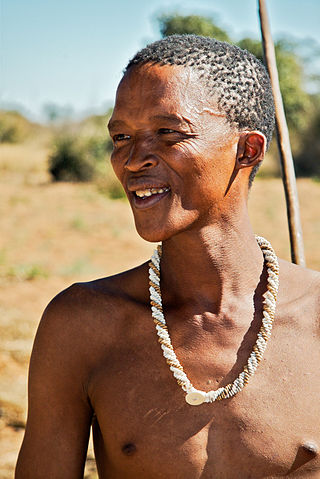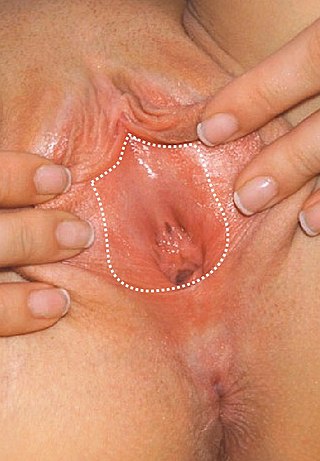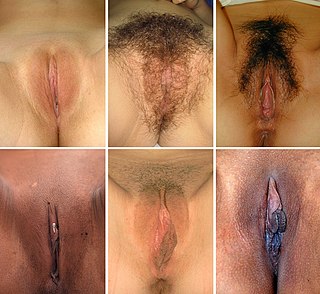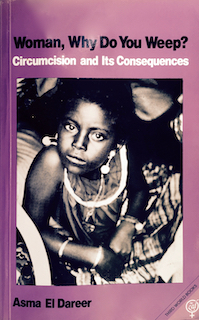
Female genital mutilation (FGM) is the ritual cutting or removal of some or all of the vulva. The practice is found in some countries of Africa, Asia and the Middle East, and within their respective diasporas. As of 2023, UNICEF estimates that "at least 200 million girls... in 31 countries"—including Indonesia, Iraq, Yemen, and 27 African countries including Egypt—had been subjected to one or more types of FGM.

The labia minora, also known as the inner labia, inner lips, or nymphae, are two flaps of skin that are part of the primate vulva, extending outwards from the vaginal and urethral openings to encompass the vestibule. The labia minora are situated between the labia majora and together form the labia. They vary widely in size, color and shape from individual to individual.

Genital modifications are forms of body modifications applied to the human sexual organs, such as piercings, circumcision, or labiaplasty.

KhoisanKOY-sahn, or Khoe-Sān, is a catch-all term for the indigenous peoples of Southern Africa who traditionally speak non-Bantu languages, combining the Khoekhoen and the Sān peoples. Khoisan populations traditionally speak click languages and are considered to be the historical communities throughout Southern Africa, remaining predominant until European colonisation in areas climatically unfavorable to Bantu (sorghum-based) agriculture, such as the Cape region, through to Namibia, where Khoekhoe populations of Nama and Damara people are prevalent groups, and Botswana. Considerable mingling with Bantu-speaking groups is evidenced by prevalence of click phonemes in many especially Xhosa Southern African Bantu languages.

Hottentot is a term that was historically used by Europeans to refer to the Khoekhoe, the indigenous nomadic pastoralists in South Africa.

Sarah Baartman, also spelled Sara, sometimes in the diminutive form Saartje, or Saartjie, and Bartman, Bartmann, was a Khoikhoi woman who was exhibited as a freak show attraction in 19th-century Europe under the name Hottentot Venus, a name which was later attributed to at least one other woman similarly exhibited. The women were exhibited for their steatopygic body type uncommon in Western Europe which not only was perceived as a curiosity at that time, but became subject of scientific interest as well as of erotic projection.

The female reproductive system is made up of the internal and external sex organs that function in the reproduction of new offspring. The human female reproductive system is immature at birth and develops to maturity at puberty to be able to produce gametes, and to carry a fetus to full term. The internal sex organs are the vagina, uterus, fallopian tubes, and ovaries. The female reproductive tract includes the vagina, uterus, and fallopian tubes and is prone to infections. The vagina allows for sexual intercourse and childbirth, and is connected to the uterus at the cervix. The uterus or womb accommodates the embryo, which develops into the fetus. The uterus also produces secretions, which help the transit of sperm to the fallopian tubes, where sperm fertilize ova produced by the ovaries. The external sex organs are also known as the genitals and these are the organs of the vulva including the labia, clitoris, and vaginal opening.

Steatopygia is the state of having substantial levels of tissue on the buttocks and thighs. This build is not confined to the gluteal regions, but extends to the outside and front of the thighs, and tapers to the knee producing a curvilinear figure. The term is from the Greek stéar (στέαρ), meaning "tallow", and pugḗ, meaning "rump".

A fourchette piercing is a female genital piercing. It is a piercing done at the rear rim of the vulva, in the area of frenulum of labia minora. Many women do not have a pinchable flap of skin in the area, and are not suited for this piercing. Otherwise, placement and piercing tends to be relatively easy.

The labia are the major externally visible portions of the vulva. In humans and other primates, there are two pairs of labia: the labia majora are large and thick folds of skin that cover the vulva's other parts while the labia minora are the inner folds of skin between the outer labia that surround and protect the urethral and vaginal openings.

Labiaplasty is a plastic surgery procedure for creating or altering the labia minora and the labia majora, the folds of skin of the human vulva. It is a type of vulvoplasty. There are two main categories of women seeking cosmetic genital surgery: those with congenital conditions such as intersex, and those with no underlying condition who experience physical discomfort or wish to alter the appearance of their vulvas because they believe they do not fall within a normal range.

Labia piercings are a type of female genital piercing. This piercing can be placed either through the labia minora or the labia majora. They are one of the simpler and more common genital piercings performed on vulvas, and are often pierced in symmetrical pairs. Like all genital piercings, depending on jewellery and placement, they may provide additional stimulation to one or both partners during sexual intercourse.

The vulval vestibule is the part of the vulva between the labia minora. On the inside, the urinary meatus and the vaginal opening open to the vestibule, while the outer edge is marked by Hart's line, named after David Berry Hart.
Labia stretching, also referred to as labia elongation or labia pulling, is the act of lengthening the labia minora through manual manipulation (pulling) or physical equipment. It is a familial cultural practice in parts of Eastern and Southern Africa, and a body modification practice elsewhere. It is performed for sexual enhancement for the benefit of both partners, aesthetics, symmetry and gratification.

Clitoral hood reduction, also termed clitoral hoodectomy, clitoral unhooding, clitoridotomy, or (partial) hoodectomy, is a plastic surgery procedure for reducing the size and the area of the clitoral hood in order to further expose the glans of the clitoris.

In mammals, the vulva consists of the external female genitalia. The human vulva includes the mons pubis, labia majora, labia minora, clitoris, vulval vestibule, urinary meatus, the vaginal opening, hymen, and Bartholin's and Skene's vestibular glands. The urinary meatus is also included as it opens into the vulval vestibule. The vulva includes the entrance to the vagina, which leads to the uterus, and provides a double layer of protection for this by the folds of the outer and inner labia. Pelvic floor muscles support the structures of the vulva. Other muscles of the urogenital triangle also give support.
A vulvar disease is a particular abnormal, pathological condition that affects part or all of the vulva. Several pathologies are defined. Some can be prevented by vulvovaginal health maintenance.
Female genital mutilation in Sierra Leone is the common practice of removing all or part of the female's genitalia for cultural and religious initiation purposes, or as a custom to prepare them for marriage. Sierra Leone is one of 28 countries in Africa where female genital mutilation (FGM) is known to be practiced and one of few that has not banned it. It is widespread in part due to it being an initiation rite into the "Bondo," though initiation rite-related FGM was criminalised in 2019. The type most commonly practised in Sierra Leone is Type IIb, removal of part or all of the clitoris and the labia minora. As of 2013, it had a prevalence of 89.6%.
Nigeria has the highest rate of female genital mutilation (FGM) in the world in total numbers. It is usually experienced by girls aged 0 to 15 years old. It involves either partial or complete removal of the vulva or other injury to the female genital organs and has no medical benefit.

Woman, Why Do You Weep? Circumcision and Its Consequences (1982) is a book by Sudanese physician Asma El Dareer about female genital mutilation in Sudan. Published in London by Zed Press in association with the Babiker Bedri Scientific Association for Women's Studies, the book summarizes research El Dareer conducted on female genital mutilation (FGM) for the medical faculty of the University of Khartoum.


















